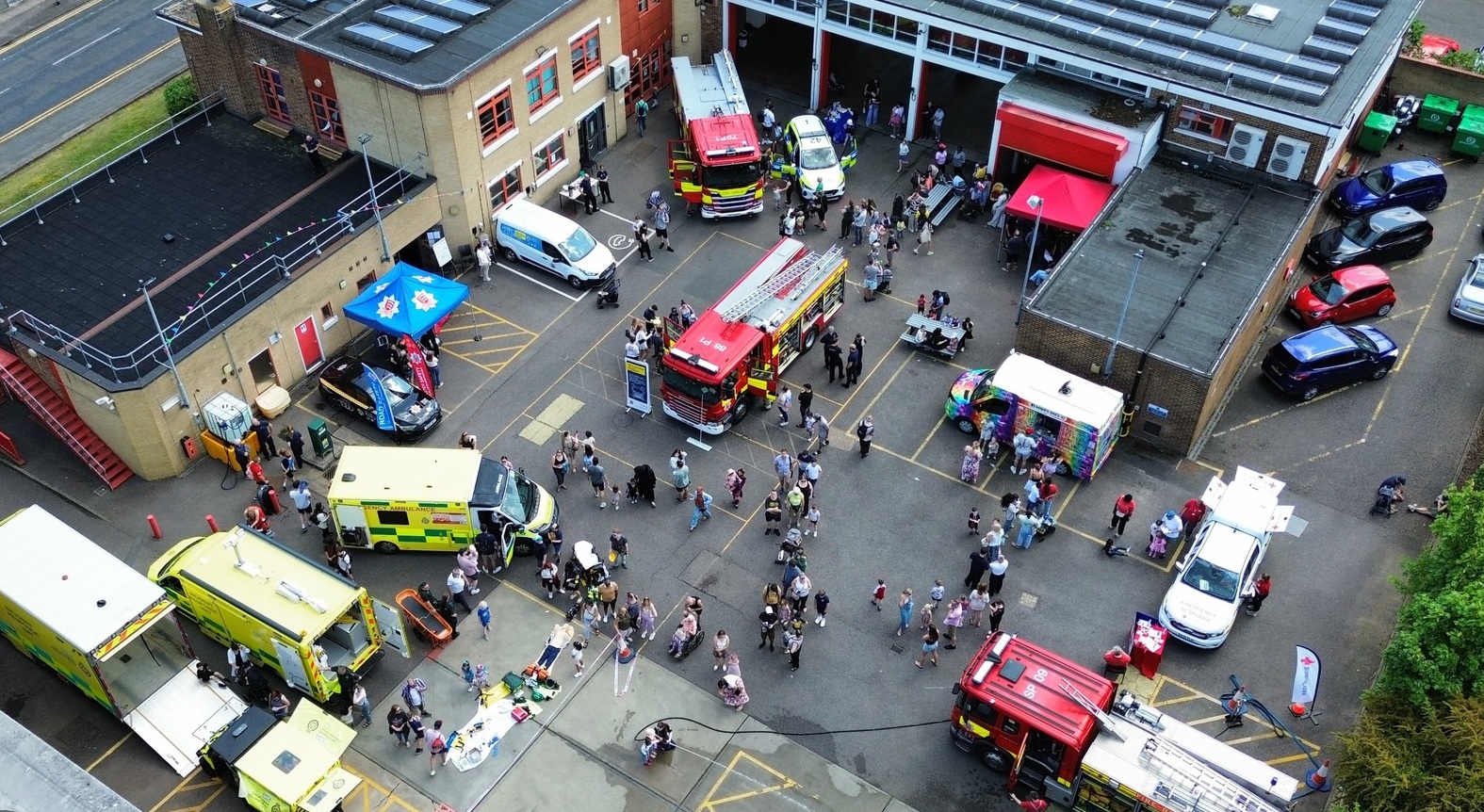Ancient Wheels of Fire – Article Three
This penultimate article will deviate slightly from the norm and feature two out of four fire appliances that were not motor-powered but had a connection to such machines. As stated in previous articles photographs of models will be used to represent the machines in question to avoid any copyright issues.
Great Bardfield Fire Brigade’s Newsham Type Fire Engine
Great Bardfield Fire Brigade’s Newsham Type Manual Fire Engine “Guzzle”
This venerable Newsham type manual fire engine was reputed to be over 100 years old when in service with Great Bardfield Fire Brigade, near Braintree. Richard Newsham died in 1743 therefore it is quite likely that Guzzle was twice that age! Originally she belonged to Sir Brydges Henniker of Newton Hall, Great Dunmow and on his death it was acquired by a Mr Smith in the mid-eighteen hundreds at the gentleman’s sale [Sir Brydges Henniker]. Mr Smith kept Guzzle at Place Farm, Great Bardfield for many years and on his passing Guzzle was handed over to the Parish Council by his executors. Initially Guzzle was pulled on a cart, by horses, to fires but if fires were close by men would pull her. This was not an uncommon procedure as it was often quicker for men to pull their fire engine a short distance rather than to fetch the horse from its stable, or field, and harness it to the engine. Once at a fire Guzzle performed well but getting to fires sometimes proved difficult. In 1885 it was reported that:
… a major fire had broken out on the night of 3 August at the premises of Mr. Joseph W. Tanner, grocer, draper, and postmaster. In a very short time the whole of the outbuildings, consisting of stable, chaisehouse, washhouse, warehouse, storehouse, gunpowder store, together with a shed the occupation of Joseph Prance, a baker, and a small outbuilding occupied by Mrs. Sparrow, were completely destroyed, with horse, trap, harness, a large amount of drapery, about three tons of sugar, hams, bacon, cheese, and various other articles … The Great Bardfield fire engine was sent for, and the Volunteer Fire Brigade called up. A large number of the latter attended, but unfortunately without the fire engine [Guzzle] that having been left at the fire at Saling Hall, Great Saling, on the 29th ult. It was sent for but did not arrive at Bardfield until nearly two o'clock on Tuesday morning. By that time, through the energies of those present, the fire was got under. The dwelling-house of Mr. Tanner, with those of several of his neighbours, had narrow escapes, and very many people were greatly alarmed, especially when the explosion took place at the gunpowder store, (Chelmsford Chronicle Friday 7 August 1885).
On Tuesday 21 September 1926 an example of Guzzle being pulled to a fire by men of the Brigade was witnessed. At 5.30pm a row of four cottages at Oyster Bridge, Gt Bardfield broke out. A score [20] of men pushed the fire engine a quarter of a mile from Gt Bardfield to the fire with their chief officer Captain Parker in charge. Their exertions obviously fell on stoney ground as all four cottages were destroyed.
Latterly Guzzle, having been serviced, was taken to fires by a second-hand lorry which had been purchased specifically for that purpose. At that time she was kept at shed in Top Yard, Thaxted Road. Ironically the shed burnt down and although she was rescued from the inferno, poor old Guzzle was no longer fit for service and was broken up in 1931 – a very sad ending for an Essex fire engine that gave “yeoman service” for around 200 years. Although the men of the Brigade performed well the demise of the Brigade followed in 1936 due to mounting expenses. Fire cover for the village was taken on by Great Dunmow and Braintree Fire Brigades, both having motor fire engines.
Great Yeldham Fire Brigade’s Newsham Type Fire Engine
Continuing the theme of manual fire engines with a link to motor vehicles, attention is now turned to another ancient Newsham type manual fire engine.
Great Yeldham Fire Brigade’s Newsham manual towed by Captain Whitlocks two-seater
Great Yelham is a small village near Halstead close to the Suffolk border. Its volunteer fire brigade, which dated back to 1894, was in possession of a horsedrawn Newsham manual fire engine which like Great Bardfield’s predated the formation of the Brigade by over a century; the origin of both machines is unknown but it is quite possible that the Great Yeldham machine once belonged to the Halstead Fire Brigade. Once at Great Yeldham the manual was housed between the Almshouses and the Reading Room in the High Street, presumably in a shed. Initially the engine was pulled by any available horse that could be found. This task was made difficult as the engine’s front wheels wouldn’t turn making it tricky to negotiate corners and it wasn’t unknown for members of the Brigade to be thrown off! In the nineteen twenties under the command of Captain Carleton Whitlock it was felt more expedient to take the engine to fires with the aid of motor transport. As Captain Whitlock was a partner in Whitlock Bros, the well-known agricultural machinery manufacturer based in the village there was a ready supply of lorries to transport it to fires. Nevertheless, there were times when one wasn’t available, and the good captain would tether the beast to his two-seater motor car and tow it to fires with the crew perched on it. Concern was raised that the fire engine plus crew would be too heavy for the little two-seater to pull. This concern was quickly dispelled when on a “shout” to Little Yeldham on arrival Captain Whitlock was somewhat distressed to note that the crew was missing as they had been thrown off en route because of the rapid progress made! It was reassuring to note that despite this setback the crew, most of whom worked for him at Whitlock’s, eventually started pumping and managed to get an impressive 30-foot jet out of the fire engine and onto the blaze.
The Brigade managed to obtain the old Halstead motor fire engine which made the manual surplus to requirements. In November 1939 the Chelmsford Chronicle reported that the old Great Yeldham fire engine was offered to the parish of Foxearth and surrounding villages, near Long Melford. A local notable David Ward wrote to the Council: “…the suggestion that we should take on the antediluvian, prehistoric, Noah's Ark hand pump now at Great Yeldham to meet our fire risks is too absurd and impossible." He was unwavering in his opinion that Long Melford should provide fire cover for the area. The prudent vice-chairman of Foxearth Parish Council disagreed feeling that the Great Yeldham machine was “quite serviceable and could be used as a standby until the Long Melford Fire Brigade arrived. Mr Ward dug his heels in and stated that, “…it is out of date and ought to be scrapped.” Ward won the day, and it was decided to ask Long Melford the amount they required for a retaining fee.
Thankfully it wasn’t the end and the Newsham was taken to Rippers Ltd Joinery Works, Hedingham where it was still in service with the Rippers Works Fire Brigade during the Second World War.
It is quite astonishing that the two Essex Newsham fire engines mentioned could well have given over 200 years’ indomitable service. One wonders if today’s machines will eventually give similar service.
Bocking Fire Brigade’s Model T Ford
Bocking Fire Brigade’s Model T Ford fire engine and trailer pump
Bocking a village close to Braintree had a well-established fire brigade dating back to the nineteenth century. The Parish Council made the decision to replace their old manual fire engines with a motor appliance and in 1924 they purchased a Model T Ford, (PU 5954) for £420 (about £8,000 today) capable of towing a Gwynne light trailer pump. This was music to the ears to members of the Brigade not only regarding efficiency, but the acquisition of the said machine elevated the Brigade’s standing in the district. The eminent industrialist W.J. Courtauld J.P. who resided in Bocking claimed he had, “no axe to grind”, when he said, “Bocking was one up on Braintree because they had a better fire engine”. (Chelmsford Chronicle 20.02.1925). This was no glib opinion as it reflected the intense rivalry between the Bocking and Braintree Fire Brigades. This division was intensified when Braintree got to know of a letter that was sent to the Bocking brigade from local farmers which extolled the virtues of Bocking’s “grand little fire engine,” (Chelmsford Chronicle Friday 7 November 1925). The letter was subsequently framed and hung, for all to see, in the engine house at the rear of the then Black Boy public house (now the Retreat). Further antagonism between the two brigades was generated as the Bocking chaps wore shiny brass helmets and their Braintree counterparts didn’t. Further, there was an occasions when the Bocking brigade appeared at a local fete and caricatured, not in a positive way, the Braintree brigade which understandably did not go down well in certain quarters.
All this was too much for Braintree and the Council made the decision to purchase a brand-new motor fire engine to replace its elderly manual appliance which would be significantly more powerful than the Model T. Braintree Urban District Council resolved to purchase, for £945, a Dennis motor fire engine with a pump capable of pumping 250-300 gallons per minute (gpm). Other makes had been considered including: a Merryweather 350 gpm at £990; a Gwynne 8 100 gpm at £415 and a Choat-Renault demonstrated by the Gt Burstead Fire Brigade in February 1925. The brand-new Dennis G Type (TW 730) arrived at the Tank Yard Fire Station in November 1925. Nevertheless, this did not stop the rivalry between the brigades which continued into the New Year. Braintree dropped the idea of supporting nearby parishes with their new Dennis unless it was paid to do so. But Bocking would support them with their “£800” fire engine – £400 in reality! By 1927 financial arrangements seemed to have shifted somewhat. In March of that year Black Notley agreed to continue to pay Bocking a retaining fee of £5 for fire cover even though Braintree would supply their much bigger, more powerful and more expensive fire engine free of charge. It was felt that the little Ford was far more agile around the narrow country lanes that surrounded Black Notley. This was yet another slap in the face for Braintree which no doubt was much appreciated in Bocking circles.
In September 1928 it was the turn of Braintree to get one up on their rivals. The Bocking fire engine was called to a farm fire at Shalford. When it arrived at the farm the machine attempted to start pumping and immediately broke down. The Braintree Fire Brigade was sent for to assist, this must have spurred the embarrassed Bocking crew on as they “borrowed” a magneto from a tractor and started pumping from a brook which quickly ran dry, and all the haystacks were destroyed. The reaction of the Braintree crew is unknown, but one can guess!
As a result of reorganization of Rural District Fire Brigades in November 1929 a new and up-to-date Morris fire engine, (VX 2361), was acquired by the Braintree Rural District Council for use by the Bocking Fire Brigade under the Council’s scheme for dealing with fires in their area. The Morris was to be housed at Bocking and as a result it was decreed that the Ford, with its Gwynne trailer pump, be sent to Kelvedon where it remained. Hostilities finally ceased between the two brigades when in the spring of 1934 the two brigades merged.
West Ham Fire Brigade’s Lloyd & Plaister
West Ham Fire Brigade’s Lloyd & Plaister Escape Carrier c 1909
The data base held at the Essex Fire Museum indicates that this fire appliance was the first purpose-built machine to be purchased by an Essex fire brigade as West Ham, at that time, was part of Metropolitan Essex. The Woodford Fire Brigade had a 1908 Maudsley pump escape (LN 9857) but that was acquired from the London Fire Brigade. Several other Essex fire brigades were equipped with motor appliances which also predated the Lloyd & Plaister, but they had been converted from powerful saloon cars to tow steamers, etc., due to the unavailability of horses during the Great War.
Lloyd & Plaister was a local engineering company founded by two local men. It was based at the Motorworks, Station Road, Wood Green but its roots were in High Holborn when George Hurst and Lewis Lloyd formed an engineering and car making company registered as Hurst & Lloyd. The company ran from 1897 to 1900. In 1900 Hurst left the company to go it alone. Lloyd then formed a partnership with William Plaister hence Lloyd & Plaister. William, the son of a surgeon, was born in 1878 at Tottenham, Middlesex and died at Clevedon, Bristol in 1956. Lewis was born in 1877 at Muswell Hill, also in Middlesex, and died at Edmonton in 1924.
The West Ham Fire Brigade (WHFB) purchased this appliance in 1909 during the tenure of Chief Officer Edward Smith. It would seem the Lloyd & Plaister was the responsibility of Henry Johnson the foreman mechanic of the WHFB, he eventually left the Brigade for the position of resident engineer to the Gloucester Fire Brigade. Both he and Chief Officer Smith had served with the LFB as had many other senior officers in the county. The Lloyd & Plaister, stationed at Balaam Sub-station, Plaistow, did not carry a pump and it would seem from contemporary images that the appliance carried a quantity of hose at the rear of the vehicle, not in reels but flaked which was unusual in this country but not in the United States. There is no doubt that this was a very impressive machine. Word must have spread regarding its capabilities. In July 1910 the Barnet Press reported that the chairman of the Southgate Fire Brigade Committee and a councillor visited WHFB to look at their motor fire engine with a view to purchasing a similar example. Expectations must have been met as Southgate, soon after the visit, purchased a similar vehicle.
Lloyd & Plaister was a relatively small concern which in the fullness of time has been largely forgotten. Nevertheless, it was a resourceful little firm not only producing motor cars but adapting and developing elements of their design to produce fire appliances including an early motor chemical appliance which was produced in 1908. Between 1912 and 1915 the company produced the Vox light motor car of which around 50 were produced but it is unknown just how many fire appliances they eventually produced.


